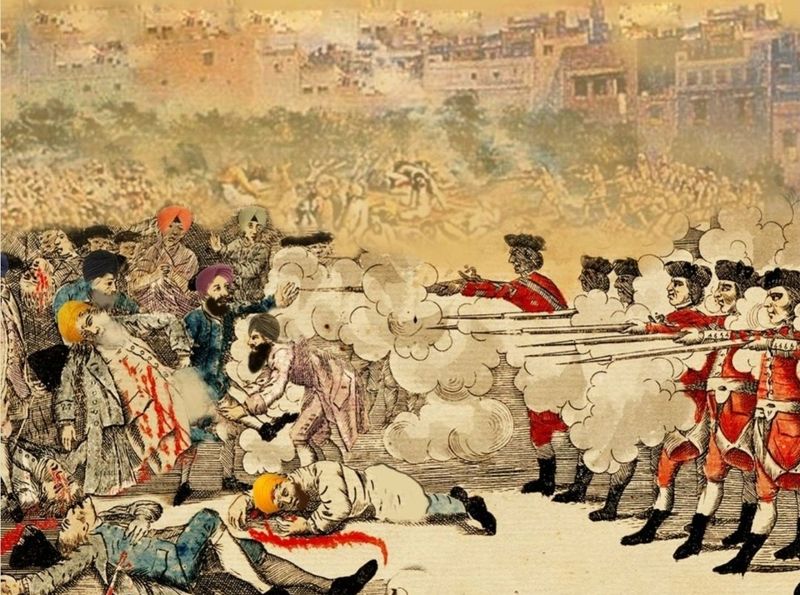The History Of Jallianwala Bagh
The Jallianwala Bagh Massacre, also known as the Amritsar Massacre, occurred on 13 April 1919 when British forces opened fire on a sizable gathering of unarmed Indians in Amritsar killing several hundred and injuring many more. It was a turning moment in India's modern history since it permanently damaged relations between the two countries.

Public meetings were forbidden under the brutal Martial Law that the British had enforced. Unaware, about 5-10,000 people gathered in Jallianwala Bagh to commemorate the festival of Baisakhi on 13 April 1919. On receiving information about the gathering, Brigadier General R. E. H. Dyer encircled the public with his soldiers.
The Jallianwala Bagh had just one exit and was otherwise entirely surrounded by walls. Without giving the throng a heads-up or asking them to disperse, the only exit was blocked and the General instructed his soldiers to open fire on the crowd. The soldiers continued to fire until they ran out of ammo. Estimates of the fatalities range from 379 to over 1500 individuals, while nearly 1,200 more people were hurt.
The incessant firing forced everyone to bustle and caused stampede, killing hundreds of Indians. Many people, including children, jumped into the well to avoid the gunshots because there was no other way to get away. The military promptly departed from the area when they stopped fire, leaving the dead and injured behind.
The tragedy led the British Army to re-evaluate its use of force against civilians and adopt a policy of "minimum force whenever possible." The total number of fatalities is still in question. After the event was investigated by the Indian government, Dyer was censured for his conduct and required to leave the service in 1920. Amritsar's Jallianwala Bagh location is now a national monument and one of the top places to visit in Amritsar.
There were around 1,650 shots fired during the 10-minute shooting. As word of the shooting and the British response circulated across the subcontinent, resentment among Indians intensified.
Rabindranath Tagore, a Nobel Prize-winning poet from Bengal, learned about the incident in May 1919. He attempted to organise a protest gathering in Calcutta before deciding to "symbolically" forfeit his British knighthood that had been awarded in 1915.
To investigate the massacre, a commission was formed. In 1920, the later-named Hunter Commission condemned Dyer for his conduct. The slaughter was cited by the Committee as one of the most ominous moments of the British Administration. The name of General Dyer is imprinted in the history of Amritsar and will be remembered for generations to come.
Michael O'Dwyer, the lieutenant governor of Punjab at the time of the slaughter, was assassinated by Udham Singh in 1940. O'Dawyer had given his approval to Dyer's move and was thought to be the mastermind behind it. Singh was an activist for India’s independence and a victim of the incident.
The Present
Some historians saw the incident as a turning point in the British Empire's dominance in India. On 1 May 1951, the central government established the Jallianwala Bagh National Memorial Trust which further tasked American artist Benjamin Polk to make the flame of liberty. Dr. Rajendra Prasad, first President of India, inaugurated the memorial on 13 April 1961. Several memorial buildings, a gallery and a museum are now located on the 7-acre property. The well and the area of the wall with the bullet holes have been kept in remembrance.

The Memorial Trust oversees its management. The Martyr's monument, a substantial building with a plaque listing "120" as the number of dead that were retrieved from the well, surrounds the "Martyrs Well”. Topping the list of historical places in Amritsar, Jallianwala Bagh still reminds of the brutal killings and the pain is etched in the heart of India. The site is open to public from 6.30 am till 7.30 pm every day. The place continues to foster patriotism in the kids and serves as a symbol of sacrifice and effort.
The year 2019 marked 100 years of the monstrous day and dedicated to the same, Yaad-e-Jallian Museum was opened in March 2019 in Red Fort. The museum featured an accurate recounting of the massacre but is temporarily closed. Jallianwala Bagh underwent renovations by the Indian government from 2019 to 2021. Many individuals condemned the refurbishment, saying it was done improperly and that it had obscured the sadness of the slaughter.
The renovation included the opening of museum exhibits and the beginning of a light and sound spectacle which is presented here every evening now. It is an amazing and moving experience to watch the performance. The show recreates the Jallianwala Bagh events of 1919 and is voiced-over by actor Amitabh Bachchan.
Murals and sculptures have also been added to the walls of a small passageway, through which British forces under Brigadier General R.H Dyer entered the park, to honour those who lost their lives on that tragic day. A transparent barrier has also been placed across the Martyrs' Well, where many individuals are thought to have leapt to escape the gunfire.
Keeping the memories of this tragic incident alive, let us explore other sites in the city of Amritsar. Located only 5 minutes away, Golden Temple and Akal Takht (400 m) are some other favorite locations for the visitors. Holding the highest place for the followers of Sikhism, these two are well-known for their beauty and blessed surroundings.
Khalsa College Amritsar (6.6 km) is another magnificent structure built across 300-acre campus and is famous for its architectural beauty.






 0
0
 1593
1593












Leave A Reply
Your email address will not be published. Required fields are marked *{{c.name}}